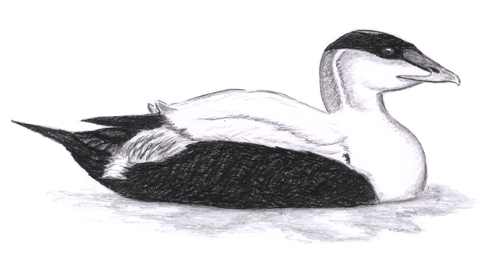
Dear Bird Folks:
I have a question about common eiders. I understand that they eat mostly shellfish. My question to you is: How do the eiders open the shells of these clams or mussels? Do they crack them open with their huge looking bill or do they bang them open on submerged rocks? However they do it, it must happen underwater, because after hours of observation, I’ve never once seen them come up with food.
Sue, Brewster
You know, Sue
That’s a pretty darn good question. I would be willing to bet that if you told 50 people that eiders eat clams, 100 percent of them would say, “Oh, that’s nice.” Whether they actually cared about what eiders ate or they were just going along with you in hopes that someone will change the subject, isn’t important. The interesting thing is that no one will ever say, “Really, how the heck does a duck open a clam?” That’s just one of those questions in life that somehow fell through the cracks and has never been asked, until now, thanks to you, Sue.
Well, the reason why no one has ever asked this question before is because eiders don’t open clam shells or mussel shells or any other kind of shells. How do they feed on shellfish without opening them? They simply swallow the mollusks whole. That’s right, the eider grabs a mussel (their favorite food) that is clinging to a rock below the surface and swallow it whole, shell and all. The very much surprised mussel is then ground up in the bird’s powerful gizzard. As many as 180 mussels have been found ground up in an eider’s stomach. Besides being able to eat whole shellfish without chewing, here is some other good stuff about eiders that you may not know.
Eiders have the ability to withstand frigid ocean waters and air temperatures of 50 below zero. It is their thick insulation of feathery down that keeps them from instantly turning into duck-sicles. It is also this down that makes common eiders a favorite of northern Europeans. The female eider lines her nest with a layer of down that she plucks from her breast. Down hunters harvest (i.e. steal) the down out of the bird’s nest and sell it to Sweden’s L.L. Bean-son, to be used in high priced outerwear.
Although the birds aren’t pleased with this transaction and receive no compensation, they simply pluck out a bit more down and get on with sitting on their eggs. Once hatched, the young ducklings jump right into the icy ocean waters, forming large rafts made up of other ducklings from other nests in the colony. The hen eiders, who haven’t eaten one beak of food since nesting began four weeks earlier, now leave in search of food. The baby ducks are left to be protected by “baby-sitter” ducks. These baby-sitter ducks are often 1 year old ducks that are still too young to breed, but still old enough to watch the kids for five bucks and hour, while they talk on cellphones and eat pizza.
Where are the adult males and why aren’t they watching their offspring? (Believe me, Sue, you are not the first person to ask this question.) They have long ago left the breeding grounds and headed farther north to molt. Eiders aren’t able to fly during the molting period, so they need to find an area safe from predators and rich with food. Using their wings to help them swim underwater, eiders have been known to dive down to over 20 meters searching for mussels. (Twenty meters, that’s deep isn’t it? I don’t really know, but it sounds deep.) When panicked, eiders also have the ability to blast out from under the water into full flight, just like a missile or a tourist from New Jersey who has stepped on a horseshoe crab.
The North American population of eiders was all but wiped out from over hunting. (Funny how that happens.) Proper protection has slowly returned their population to healthy numbers once again. Not very common on the Cape in the summer, eiders are here in mass in the winter time. The winter waters off Chatham often have rafts of eiders that contain close to 500,000 birds. Five hundred thousand eiders is quite a spectacular and heartwarming sight for a bird watcher or for just about anyone else, unless you happen to be a mussel.